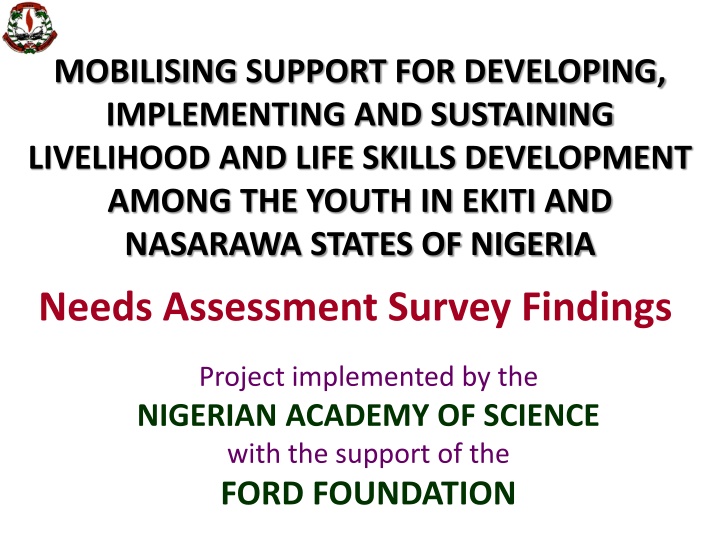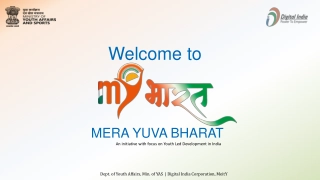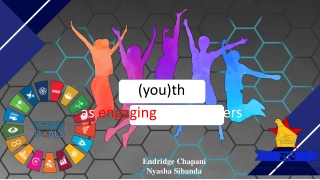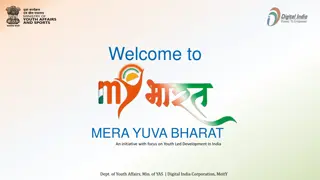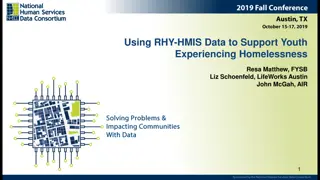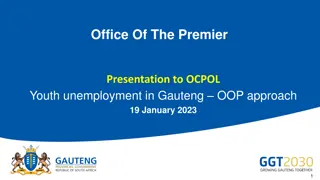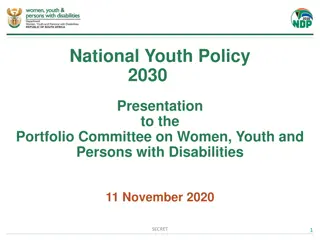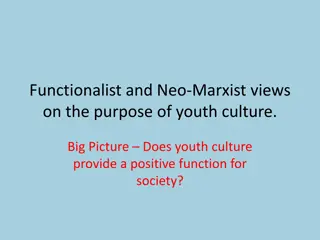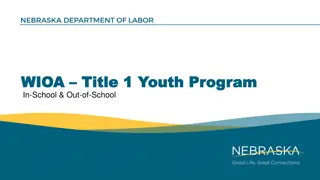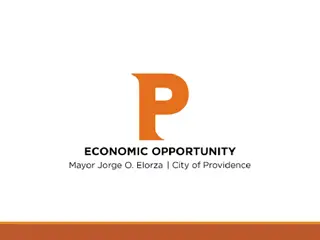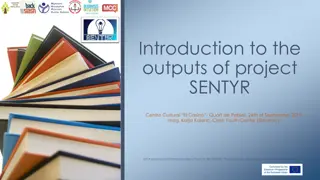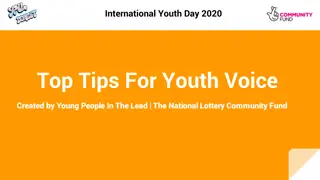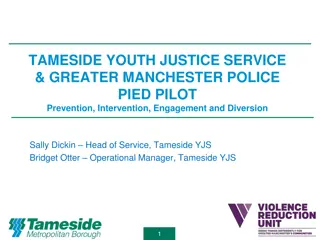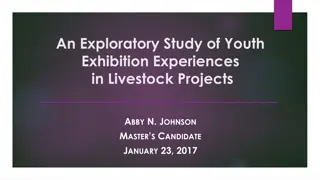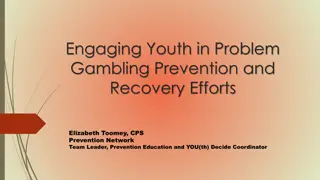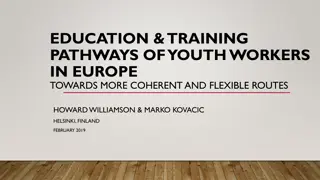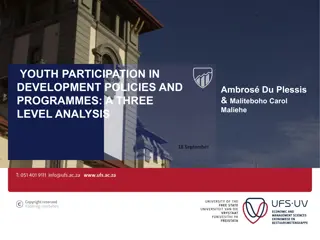Mobilising Support for Youth Development in Ekiti and Nasarawa States
This project by the Nigerian Academy of Science, supported by the Ford Foundation, aims to address challenges faced by Nigerian youth, including poor education access, high unemployment, and poverty. Through strategic planning, advocacy, and partnerships, the project seeks to improve youth livelihoods and life skills development in Ekiti and Nasarawa.
Download Presentation

Please find below an Image/Link to download the presentation.
The content on the website is provided AS IS for your information and personal use only. It may not be sold, licensed, or shared on other websites without obtaining consent from the author.If you encounter any issues during the download, it is possible that the publisher has removed the file from their server.
You are allowed to download the files provided on this website for personal or commercial use, subject to the condition that they are used lawfully. All files are the property of their respective owners.
The content on the website is provided AS IS for your information and personal use only. It may not be sold, licensed, or shared on other websites without obtaining consent from the author.
E N D
Presentation Transcript
MOBILISING SUPPORT FOR DEVELOPING, IMPLEMENTING AND SUSTAINING LIVELIHOOD AND LIFE SKILLS DEVELOPMENT AMONG THE YOUTH IN EKITI AND NASARAWA STATES OF NIGERIA Needs Assessment Survey Findings Project implemented by the NIGERIAN ACADEMY OF SCIENCE with the support of the FORD FOUNDATION
Why the Youth? Proportion of global population aged 30 & below is 50.2% [Euromonitor International] The Youth are 70% of the Nigerian population Nigerian Youth face enormous challenges: poor or non-existent access to functional education [including vocational education] high unemployment rates exposure to conflicts vulnerability to adverse sexual and reproductive health outcomes [including gender-based sexual violence] > 60% live below the poverty line
THE NIGERIAN ACADEMY OF SCIENCE (NAS) Uniquely positioned to bring scientific knowledge to bear on the policies & strategic direction of the nation Dedicated to the development and advancement of science, technology & innovation in Nigeria Promoting the growth, acquisition and dissemination of scientific knowledge in Nigeria and beyond Facilitating the use of new knowledge in the solution of major problems of national interest.
NIGERIAN ACADEMY OF SCIENCE - Response to the Challenges Facing Nigerian Youth working with state governments at the sub- national level to develop strategic plans of action for the comprehensive development of the youth helping state governments come to terms with the challenges facing youth in their localities working with states to mobilize multiple stakeholders to aggregate resources and act in concert to enhance youth reproductive health and overall social well-being starting pilot projects in Ekiti & Nasarawa States.
NIGERIAN ACADEMY OF SCIENCE - Project on Youth Development: Approach build partnerships with state governments and key stakeholders to assess the social development and reproductive health needs of youth aged 10- 24 years develop a strategic plan of action for improving the social development and reproductive health of the youth, in partnership with policymakers and other stakeholders advocacy and mobilization of the political and other civic leadership to implement the plans
NIGERIAN ACADEMY OF SCIENCE - Project on Youth Development: Goal Mainstream the promotion of the life skills, livelihood and social development of youth into the broader development agenda at all levels in Nigeria
1. Building Partnerships Activities Hold consultations with government officials in the two pilot states & obtain their commitment, support and participation in youth development Constitute technical committee involving government, civil society groups and technical experts to assess needs Conduct a systematic review of published and unpublished data on youth development & reproductive health, and the existing policies designed to meet those needs
2. Developing a Strategic Plan Activities Convey identified needs to government officials & other stakeholders, and obtain their perspectives on ways to realistically address the social development & reproductive health needs of the youth Constitute and support a committee to develop the Strategic Plan for Youth Development (SPYD) for each state Prepare policy and action plan document that will present the strengths, weaknesses, opportunities and threats associated with promoting youth development in the states
3. Advocacy and Mobilization Activities Present the action plan document to the State Governor & Executive Council Make copies of action plan available to all relevant stakeholders in the state Facilitate public presentation of the action plan by the State Governor, outlining how the plan will be implemented and how it will be captured in the state annual budget Develop/update a list of partners and stakeholders in the private sector and civil society willing to commit resources to the implementation of the plan
Progress Ekiti and Nasarawa States selected for pilot project Consultation visits to the Governors of the states and key policy makers in the states Needs Assessment done in the two states Advocacy and presentation of the needs assessment findings to key stakeholders in the two states Strategic Plan Committees set up in the two states after Action plan documents prepared for each state
Needs Assessment Objectives Document the socio-demographic characteristics of youths in the state Assess employment and occupational status of out-of- school youths in the state Document level of enrolment in schools in the state Assess the quality of science education, library facilities and access to information, communication and technology (ICT) facilities in the school system in the state. Assess the sexual and reproductive health behaviour of the youth in the state, including experiences with adverse reproductive health outcomes Assess youth access to evidence-based information and services for reproductive health Document the nature of existing policies (if any) and programmes that address youth development Assess the level of official commitment to prioritising youth development needs in the state
Needs Assessment Findings Ekiti State Highlights
Survey Methods 1 Qualitative - Focus Group Discussions (26) In-school Youth (12) Out-of-School Youth (12) Physically-challenged persons (2) In-depth interviews (36) Key Stakeholders (12) (Commissioner, PS, Directors, NGO Heads, etc) Key In-school Youths (12) Key Teaching staff (12) Inventories 12 schools (Enrolment, SSCE results, Library, ICT, Sports, Laboratory) 12 communities (Library, ICT, Sports ) Ministry of Education (State Enrolment, SSCE results)
Survey Methods 2 Quantitative - Three Senatorial Districts (Ekiti North, Ekiti South & Ekiti Central) In-School Youth 12 Schools (JS1-3 & SS1-3) Out-of-School Youth 12 communities (motor parks, barber/hair dresser shops, auto mechanic workshops) Science Teachers
Ekiti State Findings 1 Respondents 120 100 80 Out-of-school (204) 32.2% Female 51% 60 40 20 Male 49% In-school (429) 67.8% 0 Sex Youth category
Ekiti State Findings 2 Similar proportions (38.9% & 38.2%) of respondents were aged 14 years or below and 15 19 years old The most frequently mentioned basic social development needs of youth were education (84.7%) employment (6.2%), access to micro-credit (3.9%) vocational training (3.2%). The youth expected the government (52.7%) or parents (42.7%) to meet these needs.
Ekiti State Findings 3 Employment and Occupational Status of Out-of-School Youth Employment status (N=204) Yes No Occupational status (N=78) Artisan* Sales boy/girl Telecommunication Photography Trading Catering Carwash Others** No response % 38.2 61.8 32.1 17.9 5.1 3.8 2.6 2.6 6.4 12.8 16.7
Ekiti State Findings 4 Substance use among the youth (about 12% admitted to substance use/abuse) Alcohol 7% Yoyo Bitters 3% Cigarettes 1% Cannabis 0.5% Cocaine/Heroin etc 0.3% Glue 0.2%
Ekiti State Findings 5 Reproductive Health Main sources of information for youth on both puberty (53%) and reproductive health (56%)were school teachers Preferred sources of information were family members (43%), health workers (13%) and the media (11%). 51% felt they had sufficient information on reproductive health to lead a healthy reproductive life 67.8% had attended a class or seminar on reproductive health. 69.2% of such classes were organized by schools
Ekiti State Findings 6 Education in Schools Public secondary school enrolment: 34% Science Teacher: Science Student ratio - 1:8 52% of science teachers were male and 77% had university degrees Number of Students with at least 5 credits and above, including English and Mathematics, (2009 2013): 24% 33% Students pass rate in Mathematics 46% Students pass rate in science subjects (Biology, Chemistry & Physics 40% to 62%
Ekiti State Findings 7 Education in Schools Only 17% of schools had adequate laboratory space and equipment 75% of schools had a library but these were considered inadequate many schools lacking chairs and tables, having no shelves or empty shelves 67% did not have a computer laboratory or facility; those with facilities had grossly inadequate ones None of the schools had skills acquisition centres for vocational training No school had a youth-friendly centre
Ekiti State Findings 8 Facilities in Communities Only one of the communities surveyed had a public library but it had no books, tables or chairs No community had a public ICT facility but 5 of the 12 communities had private cybercafes No youth-friendly centres or specifically designated reproductive health facility in any of the communities 60% of communities had public play grounds, mostly used for football
Ekiti State Findings 9 Reproductive Health Practices Risky sexual behaviour among the youth and experiences leading to adverse outcomes of reproductive health were common knowledge of HIV transmission was high but did not seem to influence their practices Only 10% had visited a health facility in the preceding year and this was usually to government health clinic 37% of these visits were to consult about sexually transmitted infections
Needs Assessment Findings Nasarawa State Highlights
SCHOOL CATEGORIZATION SURVEY LOCATION OUT - OF SCHOOL: KEY PERSONS INTERVIEWED PLWD SURVEY INSTRUMENTS PUBLIC PRIVATE MDAs INTERVIEWEE Dir. Science & Technical Education Perm. Sec. Represe- ntatives of PLWD+ Lafia: (*NS) 1 1 MOE *Questionnaire for science teachers assessment *IDI, FGD guides for SH & youth Observational check list for RH & SD *Observational check list for sch. & comm. *Commercial Motorcyclists *Vulcanizers * Automobile Mechanics *Apprentices (males & females) in sundry vocations) MOI & Orientation Akwanga (**NN) Keffi: (***NW) 1 1 MOWA&SD 1 1 Perm. Sec & 2 Directors MOY&SD Dir. Social Dev *Nasarawa South **Nasarawa North ***Nasarawa West +Persons Living With Disability
Nasarawa State Findings 1 Survey of 556 youths - 295 males [53 %] and 261 females [46%] - target group in schools were youth in JS2 and SS2 Mean age - 16.2 3.7 years. 40.1% aged 15 19 years, implying that the school enrolment age in the state is high. Male [57%] and female [46.9%] respondents felt that the state government s girl child enrolment policy is enabling the girls to gain easier access to education.
Nasarawa State Findings 2 Substance abuse reported by young persons (Alcohol, 3.8% Glue (2.9%), Cocaine/ Heroin 1.3%) Perception of the basic social development needs of the youth: Education 89% Vocational training 9% Employment 2% Access to micro credit < 1% More than half (52%) of the respondents did not think that enough is being done to meet the social development needs of the youth
Nasarawa State Findings 3 More male science teachers (51%) than females (49%). Majority of the male science teachers had university degrees (71%) The science teacher to science students ratio was 1:26. More female science teachers had been trained on FLHE (62.5%) and HIV/AIDS (75%) More than half of the youth (54%), considered the school teacher to be the most important source of information on puberty, and 44% considered the school teacher as the most important source of information on sexual reproductive systems of men and women. In-school youth prefer to get information on sexual reproductive health from family members: mother (28%) father (6%) brother, sister and other family members (5%).
Nasarawa State Findings 4 High unemployment noted among the out- of- school youth Pass rate in science subjects was low Many teachers had not been trained in Family Life Health Education (FLHE) and Human Immunodeficiency Virus (HIV) prevention and control measures. No curriculum for FLHE in schools Teachers were the commonest source of information for students on many issues like Reproductive Health, sexuality education etc Students prefer this information to come from mothers and other family members Few teachers reported attending continuing/update educational activities in the preceding 3 years
Nasarawa State Findings 5 Infrastructure for studying and teaching science inadequate e.g. laboratory and library facilities (particularly in the public schools) Access to ICT facilities among the in-school youth highly inadequate. Infrastructure for social development (skills acquisition, empowerment, decision making) were minimal or nonexistent in schools. Inability to obtain life and transferable skills (decision making, goal setting, negotiation, time management) was also an issue among the out of school youth Skill empowerment programmes were reported to have been set up but are not sustained (many are no longer functional) Risky sexual behaviours among the youth and experiences leading to adverse reproductive health outcome (e.g. sexual relationships, unplanned pregnancies, abortion and unwillingness to go for HIV testing) were prevalent Poor knowledge of contraceptive methods by the youth
Nasarawa State Findings 6 Rate of utilization of health facilities low among the youth. People with disabilities reported not being involved in policy/decision making, especially on issues affecting them. Absence of well-articulated social development programmes for out of school youth In the public schools visited, the only social development/recreational activity was football Involvement of youth in development of empowerment schemes was inadequate Development scheme for the young persons were accessible only in the state capital Female students overall performance at WASSCE/GCE examination was poorer than in male students Affirmative action by relevant stakeholders to engage or patronize the youth that have passed through government skills empowerment programmes non-existent
Social Development Issues 1 States should establish mechanisms to obtain appropriate data on school enrolment and other parameters especially private schools. Adequate provision of ICT facilities to encourage computer based learning for in-school youth to approximate with current developmental best practises. Adequate provision of science laboratories to promote science education. Adequate provision of libraries with relevant materials to enhance reading and learning. Vocational training facilities should be provided in schools
Social Development Issues 2 Prevention and control of substance abuse should be accorded utmost attention. Training and retraining of teachers on social development issues and on modern science teaching techniques should be prioritized Registration of science teachers as members of Science Teachers Association of Nigeria (STAN) should be enforced so as to enhance the standard of science teaching Provision of education opportunities and infrastructure for skill acquisition for persons with disabilities or the physically challenged. Persons with disabilities should be involved in decision making especially in issues that pertain to their health and social development
Social Development Issues 3 Infrastructure for skill acquisition and craftsmanship for out of school youth. Creation of job opportunities for out of school youth. Existing vocational training centres established by the governments should be adequately funded and they should remain open for successive batches of trainees. Training should be structured, not sporadic Graduates of these training institutions should benefit from affirmative action programmes by government establishments in procurements and services
Reproductive Health Issues 1 Need for increased awareness/enlightenment on risky sexual behaviour and its sequelae through school health programmes. Need for increased awareness/enlightenment on effects of substance abuse. The use of peer educators should be emphasised in schools. Opportunities to encourage parental and religious involvement in addressing/educating youths on reproductive health matters should be explored. The implementation of Family Life Health Education (FLHE) programmes should be evaluated and strengthened where they exist.
Reproductive Health Issues 2 Vocational training opportunities for in-school youth should be provided through the government in order to engage them positively. Teachers should be trained in FLHE and HIV/AIDs prevention and other social issues of the infection Establishment of youth friendly clinics should be promoted in the states. Opportunities for the acquisition of life and transferable skills (decision making, goal setting, negotiation, time management etc) should be explored and established. Government should partner with NGOs, private sector, and communities in the design, implementation, and monitoring of pro-youth health related programmes.
